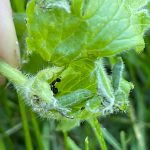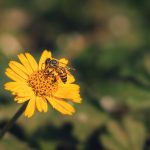One of the most frequently asked gardening questions is when the best time is to prune trees. I hear it on gardening talk radio, it regularly hits my question box, and that’s what this blog is going to tackle.
Let’s talk about why trees need to be pruned, when the best time is to prune trees, and general principles of tree pruning through the first few years of a tree’s life.
I would like to thank Jordan from Sunstar Nurseries Ltd., and Rob of Spencer Horticultural Solutions for their collaboration and expertise in putting this blog together.

Why Do Trees Need to be Pruned?
Trees require maintenance to stay healthy and strong.
They need to be pruned the right way, at the right time of year, and at the right time in their life cycle.
Tree Pruning Improves Tree Health
Tree strength and wellness are promoted by using the 3D’s of Tree Maintenance for pruning:
- Dead
- Diseased
- Damaged
DEAD
Remove dead tree structures like branches, leaves, flowers, and old fruit. Dead structures are literally dead weight. They hang on the tree, don’t contribute anything to the tree’s life, and they suck energy from the tree.
DISEASED
Eliminate or control infected branches. Disease and insect infestations weaken trees. It is vital to stop any potential spread of disease within trees and to other trees. Infected branches take energy from the tree that could be used for solid, strong growth.
Interior branch crossings are a weak spot for trees. Any branches that cross, rub, or are growing inward to the trunk will eventually weaken the tree by damaging the bark. Bark is a tree’s first line of defence, much like the protection human skin provides. A break in a tree’s bark creates a vulnerable spot to welcome bug infestations or pathological infections. Prune these out early in a tree’s life to set up its primary form.
DAMAGED
Clear away physically damaged or torn branches caused by storms, rough play, or bugs. Take these out with a new, clean cut. This will facilitate wound healing and tree strengthening.
- Sunstar Nurseries of Edmonton suggests applying a wound sealer like Lac Balsam Artificial Bark. Even though this is debated in some arboriculture circles, they feel it is a good idea and helps prevent infection.

Tree Pruning Limits Tree Growth & Keeps Your Yard Safe
Trees can be a safety hazard if they aren’t maintained properly.
Unbridled tree growth results in multiple half-strong branches and few solid branches leading to a disproportionately heavy canopy. Trees with a canopy more extensive than its root structure lack adequate anchoring, become unbalanced, top-heavy, and unpredictable in stormy weather.
Proper pruning encourages strong limb growth and keeps it from outpacing root growth.
Tree pruning decreases fire hazards, too. Overgrown trees near buildings can provide fuel for raging fires. Keeping tree growth in check limits tree size and decreases fire threats.
Tree Pruning Keeps Your Garden Space Beautiful
Beautiful trees improve property value. Pruning maintains optimal shape, increases fruit quantity and size, and adds to the financial worth of home.
When Should You Trim Trees?
Before pruning any tree, know what you want to accomplish.
Is the overarching objective to improve tree health, to set tree shape, maintain yard safety, or bolster fruit production? Your goal will determine how you move forward.
Always research the specific tree species before pruning. All trees have individual characteristics and unique needs; and if you have questions, consult a local arborist. Their expertise is worth the cost of a consultation and avoiding serious pruning mistakes.
The best time to trim trees involves balancing time of year and tree age.
The Best Time of Year to Trim a Tree

Deadwood can be Trimmed out Any Time of the Year
Mild pruning to take out dead branches can happen any time of the year, especially if safety is threatened. Be conservative and take out only what is necessary. In the cold months of the year, like fall and winter, healing happens slowly. The less you can cut, the better.
End of Winter Pruning
Pruning at the end of winter or earliest part of spring is called dormant pruning. This is the best season to prune most trees, during a small window in late winter, just as the coldest part of winter has passed. In the Edmonton area, this is generally later in March and early April.
Try to time pruning after the last hard frost as dormancy is ending and right before the trees begin to leaf out in early spring.
This is the best time to prune trees because:
- Branches are seen more easily without leaves.
- The rest of the garden is still dormant, so it is less disturbed.
- Trees can heal cuts quickly and the risk of fresh cut exposure to extreme cold that could cause further damage has passed.
- Vigorous, new growth is stimulated as energy stored in the roots transfers up the structure of the tree for the season’s new growth.
- The tree has the entire summer to branch out.
Fruit trees are part of this scenario, too. Most fruit trees need to be pruned in the early spring before leafing out. There are very precise methods for pruning different fruit trees, be sure to research them thoroughly.
Summer Pruning
Summer pruning is done after spring growth has ceased and sap flow is complete. If trees are pruned during the active growth phase or when they are budding, trees can ‘bleed out’ sap because of the high sap flow.
This kind of pruning happens after seasonal spring growth to reduce leaf surface for:
- Slowing down tree growth and developing better branching.
- Correcting crooked or unreliable growth.
In Alberta, Elm trees have a strictly enforced pruning ban from April 1 to October 1 because of the issues associated with the spread of Dutch Elm Disease.
Fall or Winter Pruning
For most species, autumn and winter are not good times to prune because the tree is either dormant or going dormant; and shifting its resources to fortify its roots, resulting in less available nutrients for wound healing and fighting disease through the open cuts.
Pruning in fall and winter makes trees vulnerable to adverse events, such as extreme temperature fluctuations, heavy frost, and snow.
Some exceptions to this rule are to cut out Black Knot Fungus, work around Elm pruning bans, or for safety.
Prune Trees When They are Young
Prune trees in the early stages of their lives to lay out their primary structures. Small trees tolerate more pruning than large ones because they have more live cells in their limbs than older trees.
Prune and shape trees when they’re young and stay on top of pruning every couple of years to keep them on track, and so the interior branches don’t get too large to prune off when the tree is more mature.
As a rule, never prune off more than 1/3 of a tree’s branches at any given time.
Tree Pruning in the First Year of Planting:
If possible, try not to prune a tree in the year it was planted. The goal is to have maximum leaf area available to photosynthesize, produce strong roots, and reduce stress.
Remove damaged, broken, or dead branches close to the trunk with disinfected, sharp tools just outside the tree collar at the time of planting. The tree collar is a swelling where the branch meets the tree trunk. Keep the tree collar intact.
Tree Pruning the Second Year After Planting:
Look for any galls, unusual, or swollen growth. This could be from insects living close to the trunk or from disease.
Prune off any branches competing with the leader. A tree leader is the main stem growing upward, defining the trunk growth. Double leaders can create a weak crotch angle that is susceptible to breaking.
Tree Pruning 3-4 Years After Planting:
This is the time for establishing great roots and establishing one strong leader. Prune off any root suckers coming from the base; these steal energy from the rest of the tree. Trim off broken limbs.
Take out cut and torn branches. Cut off and thin excess branches to maximize light, water, and nutrient availability. Cut off rubbing and crossing branches; they will cause breaks in the bark integrity. Lateral branches shouldn’t have a width more than 1/2 or 3/4 of the width of the main trunk.
For more information on trimming trees, here are some excellent resources:
Related: The Arbor Day Foundation is a great resource for tree information.
- ‘How to Prune Young Shade Trees’
- ‘Arborist Advice: Why Should You Prune Your Trees During the Dormant Season?’

Cutting to the Chase
The best approach to trimming trees is one that is knowledgeable about the specific needs of each tree and goals for pruning. It balances time of the year and tree age. Every tree is different, so every time you prune should be strategic to how your tree will respond.
Remember to consider safety issues, like nearby buildings and electrical lines, size of the tree, and other logistics. If you are unsure about how to prune a tree, how to do any complicated pruning, or how to navigate surrounding environmental factors, it is always best to get professional help.
©Sharon Wallish Murphy ©Gardening with Sharon






























